Menus
- Superbike for the masses
- Inline four-cylinder of the GPX 750 R served as the basis
- At 234 kilograms heavier than the competition
- Information about the Kawasaki ZXR 750
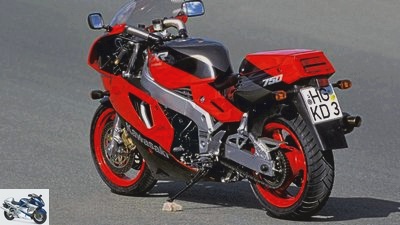
Zerha
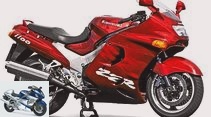
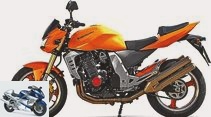
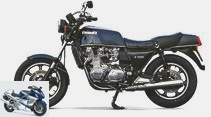
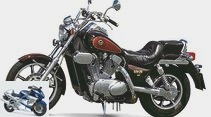
10 photos
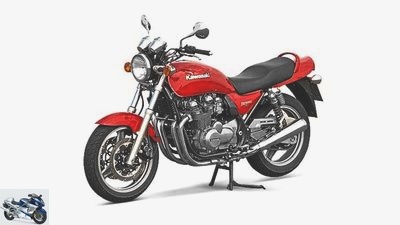
1/10
1991 Kawasaki Zephyr
The alternative to higher-faster-further: the naked bike with air-cooled four-cylinder took up classic design elements, offered as 550, 750 and 1100.

2/10
1990 Kawasaki ZZ-R 1100
Even when the car was stationary, it seemed to be bursting with power and openly came threateningly close to the magical 300 km / h mark, and was long considered the world’s fastest production motorcycle.
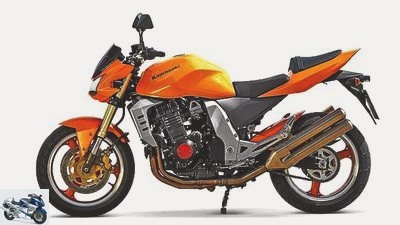
3/10
2003 Kawasaki Z 1000
The series fighter picked up on old traditions: The four exhaust pipes should be reminiscent of the legendary Z1. The engine came from the super sports car ZX-9R, had 127 hp.
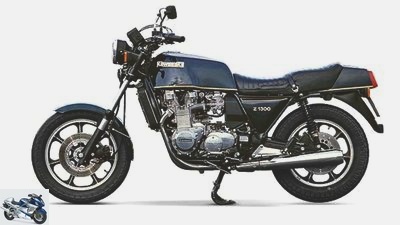
4/10
1979 Kawasaki Z 1300
The mighty six-cylinder with cardan shaft and 120 hp, presented at the end of 1978, was the answer to Honda’s CBX. The arms race in terms of displacement and power was in full swing.

5/10
1988 Kawasaki VN-15 SE
The soft chopper wave of the early 80s was followed by the big twins. With the VN-15, Kawasaki once again set a benchmark: it had the thickest cylinders to date.

6/10
1966 Kawasaki 650 W1
The first flop: The W1 goes back to a machine from the manufacturer Meguro, which was bought by Kawasaki. This in turn had copied the look of a British BSA A7.
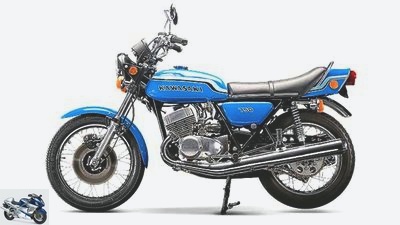
7/10
1969 Kawasaki H1 Mach III
The first hit: shown to the amazed public in 1968, sold worldwide from 1969. The outwardly almost identical H2 (photo, from ’71) with 750 cm³ ran a frightening 205 km / h.
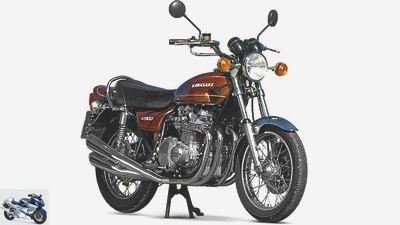
8/10
1973 Kawasaki Z1 900
“Frankenstein’s Daughter”: Cracked the 200 km / h sound barrier easily as a four-stroke – ideal to really show the philistines! The Z1 was the revolutionary motorcycle of the 70s.
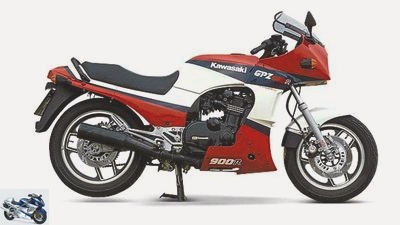
9/10
1984 Kawasaki GPZ 900 R
With the water-cooled GPZ, Kawasaki had entered the modern age of motorcycle construction. It was followed by the 600 R, 750 R, 1000 RX and 500 S, one of the most successful series.

10/10
1989 Kawasaki ZXR 750
The vacuum cleaner: the trademark were the two hoses through which the suction air was supposed to be pressed into the airbox at high speeds to promote performance.
Cult bike Kawasaki ZXR 750 from 1989
Superbike for the masses
Don’t stand on the hose any longer, sit behind it. For example on the first affordable super sports car of the modern era, the Kawasaki ZXR 750.
In 1989 Kawasaki brought a sensational technological highlight to the motorcycle world: the “dynamic pressure ventilation on the top of the engine”. It’s just a shame that the motorcycle world didn’t want to really open up why a valve cover should be blown in addition. Instead of awe-inspiring amazement, the air ducts, which looked hard to look like racing but were completely superfluous in the standard trim, were just ridiculed. Even today, every over 40-year-old sports rider knows which motorcycle model is meant when the keyword “vacuum cleaner hoses” comes up Kawasaki ZXR 750.
Buy complete article

Cult bike Kawasaki ZXR 750 from 1989
Superbike for the masses
Kawasaki ZXR 750 deserves significantly more respect, but even on its 25th birthday, so far only a small, conspiratorial group has valued its true qualities. Every bet that in ten or 15 years it will have been: “Oh, if only I would have bought one back then …” The ZXR 750 is already a milestone from today’s perspective, because with an entry price of 15,150 marks it made the topic of superbikes for affordable for the masses.
Inline four-cylinder of the GPX 750 R served as the basis
At the end of the 1980s, anyone who wanted a thoroughbred racer that was to be taken seriously and matched the Superbike World Championship that started in 1988 had to pay between 24,000 and 36,000 marks to buy a Suzuki GSX-R 750 R, Yamaha FZR 750 R (OW01) or even a Honda VFR 750 R (RC30) to get hold of. As the smallest of the Japanese motorcycle manufacturers, Kawasaki was a little late. With the GPX 750 R presented in 1986, they were the last Japanese supplier to have a 100 hp 750 cc in their range – a more touring 750 cc. As a basis for the Kawasaki ZXR 750, however, its inline four-cylinder was always suitable.
And so the Kawasaki technicians planted a new cylinder head with speed-friendly bucket tappets on the practically unchanged GPX crankcase, and gave the crankshaft a lower flywheel,
strengthened the clutch and did a lot of detailed work. The open 107 hp engine, which was still very powerful and ingeniously sounding even after the revision, ended up in a completely new, state-of-the-art aluminum frame knitted according to the ZX-10 model, in which two aluminum profiles led from the control head to the swing arm bearing – the first edition was ready for the 1989 season the Kawasaki ZXR 750 (type H1).
At 234 kilograms heavier than the competition
Compared to its direct competitor, the Suzuki GSX-R 750, the Kawasaki ZXR 750 weighed 234 kilograms and was ten kilograms heavier, but it offered a more humane workplace, a more stable chassis and better performance. That did not change the fact that their motorsport merits were initially quite clear and that a major revision was due in 1990. The second edition (type H2) got some parts of the 1989 racing kit, larger carburettors, a larger radiator and a modified swing arm.
It slimmed down a bit and no longer had to deal with the H1 teething problems (including fork seals, brake pads), but with an open 108 hp it was only marginally stronger. Just one year later, the J-model was completely redesigned, and the Kawasaki ZXR 750 remained in the range until 1995. The irony of history: the American Scott Russell did not become World Superbike Champion on a Kawasaki until 1993 – the first year in which the street version of the ZXR 750 competed without vacuum cleaner hoses. Many survivors of the H1 and H2 models are no longer there. The motto is therefore: Save the hoses!
Information about the Kawasaki ZXR 750
gad
Four-cylinder in-line engine based on the GPX 750 R, aluminum frame construction modeled on the ZX-10 – and Kawasaki’s discount racer is ready.
Data: water-cooled four-cylinder four-stroke in-line engine, 748 cm³, 74 kW (100 PS) at 10,000 rpm, 72 Nm at 9500 rpm, six-speed gearbox, double loop frame made of light metal, weight with a full tank 234 kg, front tires 120/70 VR 17, rear 170 / 60 VR 17, tank capacity 18 liters, top speed 236 km / h, 0-100 km / h in 3.6 seconds.
Literature: The Bucheli repair manual, volume 5105, was published in 1991, but is still available for 29.90 euros. For roughly the same price there is also the even more detailed, but English “Haynes Service & Repair Manual “. A detailed used purchase advice can be found in MOTORRAD 20/2004.
Specialists: In principle, any veteran Kawasaki workshop can screw the Kawasaki ZXR 750 properly. For example, Heller & Soltau in St. Michaelisdonn in northern Germany, Kawa dealer since 1987 with a big heart for well-hungry athletes and for over 20 years a reliable MOTORRAD contact when it comes to the Greens.
Market situation: The Kawasaki ZXR 750 is still waiting to be discovered by the youngtimer scene. There are currently more used machines than used machines on the market. A 100 percent original condition is the very big exception. It starts well under 1000 euros, solid goods with a valid HU are available from 1300 euros, and even (very rare) cream slices hardly cost more than 2000 euros.
CLUB / IG / INTERNET: www.zxr750.de
Related articles
-
Cult bike Yamaha FZR 1000 Exup
Hartmann cult bike Yamaha FZR 1000 Exup The big hit of 1989 Rarely has a motorcycle been improved so dramatically as the already great …
-
fact / Joachim Schahl 15th photos archive 1/15 Cult bike Kawasaki Z 1300. archive 2/15 Six cylinders, water cooling – the engine alone weighs 120…
-
Cult bike Honda GL 1000 Gold Wing
archive 6th photos Markus Jahn 1/6 Markus Jahn 2/6 Honda 3/6 Travel motorcycle with smoothness and comfort: the Honda GL 1000 Gold Wing from 1974….
-
archive 5 photos archive 1/5 BMW K 75 C.. archive 2/5 The triple is just as reliable and linear as the four, but sounds much nicer from 6000 rpm. archive…
-
7 pictures archive 1/7 Moto Guzzi Nuovo Falcone Kunstle 2/7 Expensive dream: The Moto Guzzi V7 Sport cost a whopping 8360 marks in 1972 – but today …
-
Cult bike Norton Commando 750 Roadster
Warter cult bike Norton Commando 750 Roadster 1967 a real superbike Norton swung itself back to its old size for the last time and in 1967 created the …
-
First driving report of the Kawasaki GPZ 900 R (MOTORRAD 1-1984)
Archive 26 pictures Archive 1/26 Light, strong and fast was the formula for the Kawasaki superbike of the 1980s, the GP Z 900 R. Archive 2/26 According to …
-
Hartmann 6th photos Hartmann 1/6 Cult bike Aprilia Moto 6.5. Hartmann 2/6 His furniture is a real hit, Philippe Starck’s Moto 6.5 stopped. One can…
-
Zerha / Archive Cult bike Ducati 750 F1 Dream of a motorcycle Just sold to Cagiva, Ducati gave birth to one of the most beautiful motorcycle dreams in…
-
Archive cult bike Suzuki GS 750 Amazingly mature performance Judging by the fact that Suzuki only launched four-stroke engines under massive pressure, the …